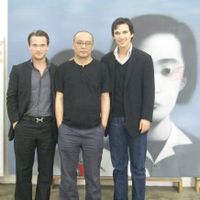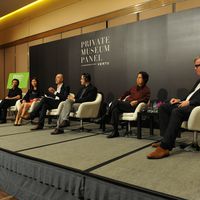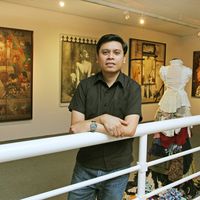Rethinking Museums | The Art Advisors - Part 2
 [caption id="attachment_10053" align="alignright" width="300" caption="Nicolai Frahm, Yue Minjun and Frank Cohen at the artist's studio in Beijing, 2007"]
[caption id="attachment_10053" align="alignright" width="300" caption="Nicolai Frahm, Yue Minjun and Frank Cohen at the artist's studio in Beijing, 2007"]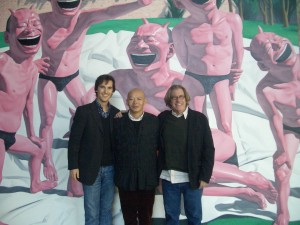 [/caption]
[/caption]In the second part of her interview, Bharti Lalwani continues her discussion with Nicolai and Michael Frahm about building Frank Cohen's art collection for his private museum Initial Access, the hunt for younger emerging artists as well as what aspects make a private museum more meaningful.
B: Could you elaborate further on your advisory role with regard to building Frank Cohen's collection and foundation?
NF: We are involved in building and representing some of the largest private collections in the world. The Frank Cohen Collection in the UK is only one of them but we've worked with Frank for more then 10 years now and launched his private foundation, Initial Access, only in 2007.
MF: With Frank and all the other collections we work with, there is a specific vision- a red thread which runs through the collection; common aspects which convey a collective sense of identity and, most importantly, equipped with a vision which looks towards the future. Together with our collectors, we have a strong sense for what the collection should represent, and the statement it should make. Finding masterpieces by any given artist or from a specific movement is a continuous effort in re-valuating which art historical figures are important or maybe overlooked. Take for example, Kenneth Noland, a very important artist from the 50's who shaped what monogram and abstract painting is today, but for some reason has become rather underrated. We think his shaped canvas or his target paintings are extremely relevant in today's contemporary art practice. This sort of almost forgotten figure is something really exciting to unravel and confront ourselves and our collectors with.
B: You've talked about the number of artist studio visits you do every year; what about collecting younger emerging artists?
NF: Yes, our aim is of course not only to find masterpieces by established artists, but we also support and promote younger emerging artists. A few years ago, we went to the studio of Anselm Reyle in Berlin; at the time he had just had a big show at Kunsthalle Zürich. I got to the studio and was blown away by how prolific his work was. It was like a new style of painting and development in studio practise. He was the director of his own works- paintings were leaning against walls everywhere, assistants were mixing paints and polishing materials. It felt like looking at a young Damien Hirst, he was full of energy. We ended up buying several of his works. We then placed most of these in collections we work with. So today, Reyle is in many of the best collections around the world and is represented by Larry Gagosian- the biggest contemporary art dealer in the world today and we are proud to have been involved with that from an early stage.
B: And that excitement you feel upon looking at such artists, how do you relay that to your collectors? What sort of deliberations are made when it comes to making decisions about including certain art works into a collection?
NF: We work extremely closely with our collectors, we become their tutors, explain the ins and outs of the art scene and guide them through art history by educating them, accompanying them along important exhibitions, take them on cultural trips abroad and organize lots of artists’ studio visits. We do this to ultimately help them develop and refine their own “eye.” We use our broad network and knowledge to give them an overall ‘experience’ of collecting and building a world-class art collection.
MF: Ultimately our decisions are made with our eye and our so-called gut-feeling. But what sounds like an instinctual decision actually comes from years of accumulated experience, years of reading up on all the news and not missing a visit to any potentially interesting artists or exhibitions. In essence, these are the elements that make a distinguished collector- one who trains his eye constantly through our set parameters and guidelines. The collector-advisor relation is a partnership and only works well if there is a constant dialogue between the two.
Art advisory has a lot to do with the strong connections we have with the younger gallerists, the so called gate-keepers but equally so with the blue chip galleries, young curators and critics; we even go to the degree shows which are followed by subsequent studio visits we do thereafter. All these fragments of research and network come together to create a bigger picture where every aspect is significant to us. Through our network we open up new channels and can help, in many instances, the younger artists to connect with let’s say a more established gallery or to be acquired by a great collection.
B: Could you site us a tangible example of an artist who's development you have followed (and consequently placed in collections)?
NF: Yes, Tomas Saraceno, an Argentinian born artist, is someone we have been following and supporting from very early on. We loved his work the instant we saw it. His practice is incredibly mysterious and diverse and through photography, sculpture and installation he challenges the conventions of art and architecture. He creates his own vision of a utopian society addressing important questions about overpopulation, migration and the politics of space and the environment.
[caption id="attachment_10061" align="alignright" width="300" caption="“Galaxies forming along filaments, like droplets along the strands of a spider's web” Tomas Saraceno at Venice Biennale 2009 (Image Courtesy Andersens Contemporary)"]
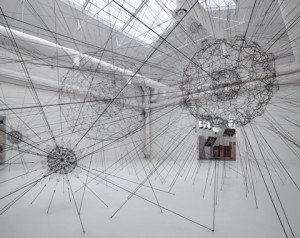 [/caption]
[/caption]We have since placed his works in major collections around the world and he is an artist we will continue to support. Saraceno had his big break in the 53rd Venice Biennial in 2009, where he created a major installation in the International pavilion called “Galaxies forming along filaments, like droplets along the strands of a spider's web.” Using long elastic ropes to construct a life-size spider web, visitors could move in and out of the structural work. It was simply fantastic! This year he is doing a major sculptural work at the rooftop of the Metropolitan Museum in New York, one of the most prestigious museums in the world, following in the footsteps of the likes of Jeff Koons.
MF: We look for that special something. The Chinese artist duo Sun Yuan & Peng Yu have that! Part of the so called ‘Post-70’s Generation’ they were prominent figures at the end of the 90s, using media and materials that were traditionally unthinkable or extremely provocative like fighting dogs, real cadavers, human fat tissue and human-bone ash. Through their strong visual language and by forcing us to question the imaginary and the real they offer us new perceptions and new modes of thinking.
Last year I visited them in China, and after going to their studio I went straight to Art Issue Projects in Beijing to see an installation they had done for a group show of seven artists called Trap. They had taken over the entire space by covering the floor with thousands of tiny and almost invisible glass balls. Entering the gallery I literally glided from the entrance to the back of the space, almost bumping into three other artists' works on the way. The glass balls were everywhere. I loved the provocative and arrogant way they took over the entire exhibition with an almost invisible work, even adding the element of danger!
NF: Can you imagine doing that in a gallery in New York? You will have one society lady walking into the space in high heels, falling and crashing into an artwork, then suing the gallery and the artists for millions. Only in China!
[caption id="attachment_10067" align="alignright" width="300" caption="“Untitled”, Sun Yuan and Peng Yu at the Exhibition “Trap” 2010 "]
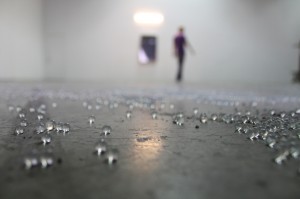 [/caption]
[/caption]MF: Exactly, Sun Yuan and Peng Yu are the daredevils of Chinese contemporary art! They are constantly experimenting and challenging the conventional art discourse and that is something we love in an artist’s work. They have that special something where you simply can’t wait to see what they will do next.
B: That sounds incredible! But what about the pitfalls of art-collecting- in terms of buying into the hype of a “brand name”? We had a number of Chinese, South Asian and Indian collectors snapping up works by Damien Hirst, Murakami, Tracy Emin, Yayoi Kusama, Subodh Gupta and Anish Kapoor amongst others at the the Hong Kong Art Fair last May, India Art Summit in Delhi and Art Stage Singapore in January this year.
MF: I think one has to be very careful especially when the media is talking about a hype or about a certain artist as being “hot”, then yes, the better judgement of many collectors start to fail and they just want to jump on the bandwagon in order to not miss out on someone or something. This is not the way we buy and more often than not, the hype disappears as fast as it came.
NF: Our focus is not on the “brand” but on the art itself- For instance, buy an early Car Hood rather than a late Check painting by Richard Prince, buy a 1991 Medicine Cabinet rather than a 2009 Skull painting by Damien Hirst, buy a 1994 Family Portrait rather than a 2008 Green Wall painting by Zhang Xiaogang or a small 1964 Flower painting rather than a large 1982 Dollar sign painting by Andy Warhol.
B: Now that we've established what goes into building a consistent art collection, lets talk more about the museum itself- how does a private museum then avoid becoming a stagnant repository of sorts?
MF: I think the goal has to be to create an active discourse with the artists in the collection. One way of keeping this discourse lively and dynamic is through the acquisitions of new works, but one also shouldn’t be afraid to sell a work if necessary. A growing collection is something organic and should also be treated as such. It has to be ‘taken care of’ on a daily basis. Artworks should be loaned to exhibitions in order to reach a wider audience. New emerging artists should be placed next to older ones in a way where traditional forms of art practice are juxtaposed with new media art. Re-curating your own collection, is the best way to discover and strengthen certain parts as well as to face yourself with weak points and artists who may be missing out altogether.
B: What, in your opinion, would be the long term impact of the private museum?
MF: The private museum is becoming more and more relevant if only for one simple reason- it can remain flexible, and it can act faster than a public museum, especially with regard to aquiring new works. Having said that, public funding is getting severely cut in the UK and in many other European countries, which poses a huge problem for the larger well-known institutions. In the US, public as well as private museums have been relying on private money for a long time which makes it a very different experience from Europe or Asia.
We, in Europe, are now starting to witness the structure and way of running museums based on the same model that we see in the US. The Serpentine is a good example of that. They have a very international approach and the system works incredibly well with its committees and donor clubs while the directors are responsible for the fund-raising. In Asia the concept of the private museum is relatively new, but it’s developing very fast and I think the private institutions we know in China and India are already proving especially important.
Within the private museum, exhibitions which are of significance in the current climate can be curated specially- We can interrogate, question and challenge the art by putting up new fresh shows very quickly and respond to current situations. The private museum can only fail if it lacks a focus or the vision of its founding member. To make the private museum a success, the collector’s vision needs to be communicated effectively, and this needs to connect with the public- reaching out to the younger generation, students, children and people who are less familiar or less engaged with the arts. Once we get the collector's vision right the possibilities are endless.
B: Do you foresee any danger in this rising trend of private museums, especially in countries where there is a lack of government funded initiatives and museum structure?
MF: China’s government for instance, has opened up to a whole new art scene, which was partly forbidden not too long ago. The government is still learning how to cope with this ‘new’ art scene and what can be drawn from it. Coming to terms with a private museum, which isn’t necessarily aligned with the government’s ideals, is something they still need to think about in the long term. The situation will progress step by step and I agree that the overall support is still not there.
B: And then there is the recent matter of Ai Weiwei's arrest which halts that very progress and takes several steps back
[caption id="attachment_10062" align="alignright" width="300" caption="Michael Frahm and Ai Weiwei at the artist's studio in Beijing, Nov 2010"]
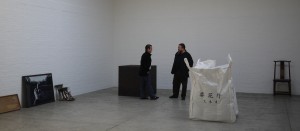 [/caption]
[/caption]MF: Yes, the detention of Ai Weiwei is both alarming and deeply concerning, but somehow it is not a surprise. Many believed that his international acclaim as well as his father's legacy, was protecting him from arrest by the Chinese government. They were wrong! Inspite of the worldwide concern expressed for his welfare, which includes a petition that went around the globe, he still remains in detention, his whereabouts unknown. Weiwei’s artistic practice and his core values as a human being are centered on the freedom of speech and the rights of the individual. I admire him for many things, not least his role as an activist consistently challenging the enforced 'status quo' in an attempt to bring about radical change. It is simply extraordinary, not to say fearless. How can China be a modern, progressive, egalitarian society without freedom of speech and individual human rights, all of the values Ai Weiwei represents and has fought for.
But let me just get back to your earlier question because India and Indonesia are too lacking substantial government backing but private individuals have begun to step forward. The case of Indonesia is particularly alarming! With hardly has any government support, it is only the local collectors who are making waves. Dr. Oei Hong Djie, whom I visited a few years back is making a remarkable contribution to the Indonesian art scene with his consistent patronage, and his collection gives a fabulous overview of Indonesian art throughout the 20th century and into the 21st. I think it is private museums such as these which make a difference. They fill a cultural gap which the governments unfortunately are creating. The same can be said for China and India. Private individuals are leading by example and the governments should not only support that, but follow as well. Notably in Beijing, Guy and Miriam Ullens opened UCCA in 2007 and in India, Anupam Poddar and his mother Lekha Poddar “went public” in 2008 with their Devi Art Foundation in Gurgaon (Delhi). There is also the new Kiran Nadar Museum of Art which opened earlier this year in New Delhi. These are great examples of private individuals who take on a public role by creating a platform for people to learn and experience contemporary art.
NF: We embrace such collectors who want to make a significant difference because they share the same passion and commitment to art as we do and that’s why we love working with private museum collections. The danger of the trend of the private museum is most probably that those collections take away potential masterpieces from important public museums, which, as mentioned prior, often cannot acquire the works fast enough. The real challenge however, for private as well as public museums, lays in creating a true legacy. Take Peggy Guggenheim for instance, she went her own way, supported the artists around her and then moved to Venice with the whole collection which is till today one of the most impressive art collections in the world. She had the eye and of course the access which enabled her to buy only the best, and that is the way to eventually end up with a great museum. Remember... it is better to build a collection of ten masterpieces than a collection of a thousand mediocre works!
Bharti Lalwani has a BA in Fine Art and an MA in Contemporary Art; She writes for several publications across SE Asia and India.
Similar content
17 May 2011

